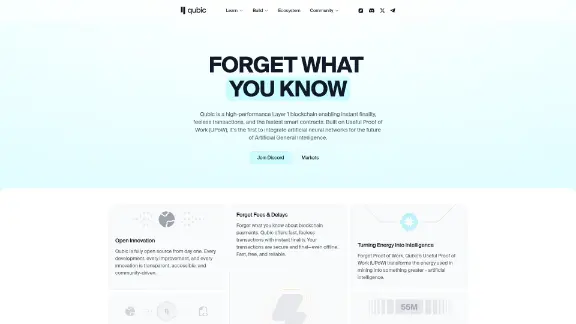Qubic (QUBIC)
Qubic is a Layer 1 useful-proof-of-work (UPoW) crypto platform established by Sergey Ivancheglo. The term "Qubic" stands for "Quorum-Based Computation" (QBC), and the platform is designed to enhance smart contract execution speed and integrate advanced AI capabilities for improved computational performance.
Overview

| Ticker | QUBIC |
| Category | Artificial Intelligence (AI) |
| Website | https://qubic.org/ |
| @_Qubic_ | |
| Telegram | qubic_network |
Qubic is an open-source cryptocurrency platform that originated in 2012. It employs a quorum-based computation system with 676 Computors for smart contract execution. The Mainnet was launched in the second quarter of 2022. The platform uses a Useful Proof-of-Work system, where mining capacities are redirected toward AI training tasks. It offers feeless transactions and commission-based smart contract execution. Each epoch generates 1 trillion Qubic Units (QUs), distributed mainly to efficient Computors, with others seeing some rewards burned. The Arbitrator manages AI training tasks on the platform, which uses direct "bare metal" code execution for Turing-complete smart contracts in C++. This approach aims to ensure reliability, efficiency, and user-friendliness.
Products
Smart contracts
Qubic's smart contracts focus on efficiency and security through a thorough approval process. Contracts undergo a Quorum proposal vote and, once accepted, are launched with 676 shares, locking $QUBIC into the contract. This reduces the circulating supply, while shareholders earn passive income from contract fees. Designed in C++, these smart contracts execute directly on bare metal for rapid execution. They utilize Qubic Units (QUs) as "energy," implementing a deflationary model where QUs are burned during execution. Integration with oracles allows the inclusion of real-world data, supporting various decentralized applications.
The Quorum Protocol
The Quorum Protocol is Qubic's main consensus mechanism, involving 676 Computors (validators) to manage transactions, smart contracts, and Oracle interactions. It requires agreement from more than two-thirds (451+) of Computors for transaction or contract outcomes, aiming for accuracy and rapid block times. The protocol uses a quorum-based computation system, selecting the top-performing Computors based on AI mining output to execute transactions on the Qubic ledger, known as the Spectrum.
Oracle machines
Oracle machines enhance Qubic smart contracts by providing accurate external data such as stock prices and sports scores. They supply smart contracts with reliable information to interact with real-world events and support Aigarth in observing external conditions and conducting outsourced computations.
AI Aigarth
AI Aigarth is a proposed artificial intelligence system for the Qubic network, aiming to create open-source AI by utilizing Qubic-AI-miners' computational power to develop and train artificial neural networks (ANNs). It harnesses unused computational resources to address AI challenges using evolutionary algorithms. Aigarth incorporates the Helix logic gate for enhanced computational efficiency and is under development as of July 2024.
Useful Proof-of-Work (UPoW)
Useful Proof-of-Work (UPoW) in Qubic redefines traditional Proof-of-Work by focusing on AI training tasks. Computors engage in AI computations, contributing to machine learning advancements and improving energy efficiency. This approach aims to enhance network security and decentralization while optimizing energy use.
Spectrum
Spectrum is Qubic's decentralized ledger system, designed for transparent and tamper-proof transaction records for each epoch. It logs transaction details immutably and can be accessed using the qubic.li Spectrum Info Tool (CLI) on any Computor. The decentralized structure aims to prevent censorship and fraud.
Use cases
Qubic's consensus mechanism and native token, QU, support several applications:
- Decentralized computing: Utilizes global computational resources for tasks like simulations and AI model training, optimizing underutilized computing power.
- Smart contracts: Provides fast and reliable execution for decentralized applications in finance and logistics.
- Micropayments: Offers feeless transactions with QU, facilitating small-scale transactions in content monetization and IoT.
- AI training: Employs Proof of Useful Work (PoUW) for AI model development and validation.
- Supply chain management: Enhances real-time tracking and automation in supply chains, reducing errors and inefficiencies.
Tokenomics
QUBIC token ($QUBIC)
QUBIC tokens, or Qubic Units (QUs), serve as utility tokens within the Qubic blockchain network, quantifying computational resources for smart contracts and oracle data access. The network generates one trillion QUs weekly, distributing about 1.5 billion QUs each week to the most efficient Computors out of 676. This distribution will continue until the total supply reaches 1,000 trillion, projected in about 19 years. A portion of QUs is burned with each transaction to manage the token supply.
Epochs
Each seven-day epoch on the Qubic network generates 1 trillion Qubic Units (QUs), primarily allocated to Computors based on performance, with remaining QUs going to the Arbitrator. The total supply is capped at 1,000 trillion. By around 2041, the burn rate of QUs is expected to match the emission rate, stabilizing the circulating supply. If the supply nears 999 trillion, a weekly burn of 1 trillion QUs is planned to maintain balance and ensure rewards.
Governance
Qubic's governance framework maintains decentralization by dividing authority between the Quorum and the Arbitrator. The Quorum, comprising at least 451 Computors, makes key network decisions like validating transactions and creating blocks. The Arbitrator handles disputes, sets mining algorithm parameters, and monitors Computor performance. This structure ensures a balanced system, preventing any single entity from controlling both the Quorum and Arbitrator roles, thereby maintaining fairness and decentralization.
